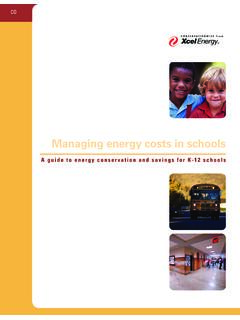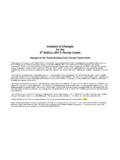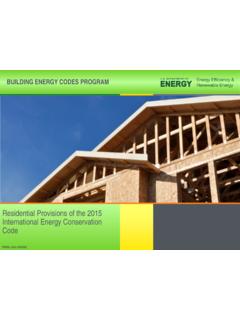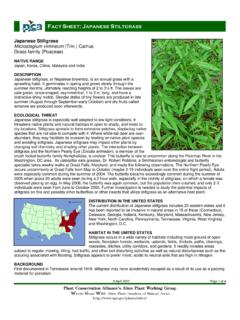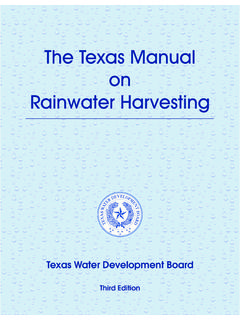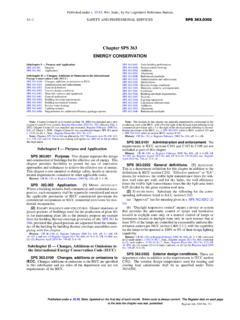Transcription of NATURAL RESOURCES CONSERVATION SERVICE …
1 590 - 1. NATURAL RESOURCES CONSERVATION SERVICE . CONSERVATION PRACTICE STANDARD. NUTRIENT MANAGEMENT. (Ac.). CODE 590. DEFINITION municipal and industrial biosolids and other organic by-products Managing the amount (rate), source, placement compost (method of application), and timing of plant waste water nutrients and soil amendments. organic matter and soil nutrient availability removal of crop materials irrigation water. PURPOSE. To budget, supply, and conserve nutrients for Documents cited in this standard may be plant production. periodically updated or replaced. Use the most recent version available. Find additional To minimize agricultural nonpoint source technical information on nutrient management at pollution of surface and groundwater RESOURCES . To properly utilize manure, municipal and Soil Sampling, Testing, and Analysis industrial biosolids, and other organic by- Base the nutrient management plan on soil test products as plant nutrient sources.
2 Results for, at a minimum, organic matter, phosphorus (P), potassium (K), pH, and buffer To protect air quality by reducing odors, pH. Test, at a minimum, every 4 years of row nitrogen emissions (ammonia, oxides of crops or once during an extended rotation which nitrogen), and the formation of atmospheric includes perennial crops. For initial plans use particulates. tests no older than 2 years and account for To maintain or improve the physical, chemical, nutrients applied at rates in excess of crop and biological condition of soil. replacement since the last soil test. Use Iowa State University's (ISU) PM-287 Take CONDITIONS WHERE PRACTICE APPLIES a Good Soil Sample to Help Make Good Decisions for soil testing guidance. For variable This practice applies to all lands where plant rate systems use NCMR-348 Soil Sampling for nutrients and soil amendments are applied.
3 Variable Rate Fertilizer and Lime Application for additional guidance. CRITERIA For soil analysis, use a lab that is certified by the General Criteria Applicable to All Purposes Iowa Soil Testing Laboratory Certification Develop a nutrient management plan for Program, Commercial Feed and Fertilizer nitrogen, phosphorus, and potassium that Bureau of the Iowa Department of Agriculture considers the crop requirements and all potential and Land Stewardship (IDALS). sources of nutrients including, but not limited to: commercial fertilizer To interpret the soil test results, use PM-1688. animal manure General Guide for Crop Nutrient and Limestone legume credits and green manure, Recommendations in Iowa and PM-1310. crop rotation Interpretations of Soil Test Results.. CONSERVATION practice standards are reviewed periodically and updated if needed.
4 To obtain the NRCS, IA. current version of this standard, see the Iowa NATURAL RESOURCES CONSERVATION SERVICE website or your county Field Office Technical Guide. October 2013. 590 - 2. The 4Rs Adaptive Nutrient Management Process . The Consider the 4Rs of nutrient management corn stalk test provides post season feedback apply the Right nutrient source at the Right rate on nutrient management that can be used to at the Right time in the Right place to improve adjust the nutrient source, rate, timing, and/or nutrient use efficiency by the crop and to placement. Document how results will be minimize nutrient losses to the surface and reviewed and incorporated into future groundwater and to the atmosphere. management. Nutrient Application Rates Phosphorus and Potassium Application Rates Determine the nutrient application rate to: For P2O5 and K2O requirements for most Meet the crop's nutrient requirements for common crops, use soil test results and PM- production 1688 General Guide for Crop Nutrient and Account for nutrient credits and rotational Limestone Recommendations in Iowa.
5 Use PM- effects 869 Fertilizing Pasture for pasture nutrient Account for removal of crop materials requirements. Express phosphorus and Conserve RESOURCES as indicated by the potassium nutrient values in pounds of P2O5 and erosion and nutrient risk assessments, and K2O. Integrate the management of manure, municipal and industrial biosolids, and other P2O5 and K2O can be managed annually or for waste products as crop nutrients. multiple years. Sum the nutrient requirements for all the crops in the years planned ( a Plan to meet the crop nutrient requirements for rotation) and apply once or split as convenient. nitrogen, phosphorus, potassium, and other nutrients according to Iowa State University Phosphorus and potassium application rates recommendations. may exceed the crop's nutrient requirements when manure, municipal and industrial biosolids, Nitrogen Application Rates and other organic by-products are applied based To determine nitrogen rates for corn in a on the N rate or need to be disposed.
6 See continuous corn or corn-soybean rotation, use Additional Criteria Applicable to Properly Utilize ISU's Corn Nitrogen Rate Calculator or use PM- Manure Municipal and Industrial Biosolids, and 1714 Nitrogen Fertilizer Recommendations for Other Organic By-Products as a Plant Nutrient Corn in Iowa. Source for management criteria. For within season sampling to determine Realistic Yield Potential sidedress nitrogen application rates, follow ISU Estimate the field's realistic yield potential using: procedures for the late-spring soil nitrate test in an average of two or more years of field yield PM-1714 or leaf chlorophyll values in PM-2026 data using producer records plus 10%, or Sensing Nitrogen Stress in Corn. the crop yield estimate for the dominant soil in the field as found in the Field Office For additional nitrogen rate information and Technical Guide, or recommendations use ISU publications: PM-1268 Establishing Realistic Yields" (1986).
7 PM-2015 Concepts and rationale for regional to calculate a more precise estimate if nitrogen rate guidelines for corn , desired. PM-1714 Nitrogen Fertilizer Recommendations for Corn in Iowa , Nutrient Credits PM-869 Fertilizing Pasture , To determine the nutrient application rate PM-1584 Cornstalk Testing to Evaluate subtract the nutrient credits for legumes, Nitrogen Management , manure, municipal and industrial biosolids, PM-2026 Sensing nitrogen stress in corn . and/or other organic sources from the crop's nutrient requirements. Note that ISU nitrogen Use of the end-of-season cornstalk test recommendations already accounts for the especially in conjunction with on-farm field trials rotational effects and legume credit for corn is encouraged to evaluate the nitrogen following soybeans. management program.
8 See ISU publication PM- 1584 Corn Stalk Test to Determine Nitrogen Legume credits can be found in ISU Publication and NRCS Agronomy Technical Note No. 7, PM-1714 Nitrogen Fertilizer Recommendations NRCS, IA. October 2013. 590 - 3. for Corn in Iowa". Use PMR-1003 "Using For nitrogen, timing and placement should manure nutrients for crop production" to correspond as closely as practical with crop nd rd determine the 2 and 3 year manure credits. uptake. For phosphorus avoid surface application when Other Rate Criteria the runoff potential is high. Account for all applied nutrients including starter, For anhydrous ammonia, to avoid losses in-furrow starter (pop-up), biosolids, and the N in during application apply when soil moisture MAP and DAP. conditions are conducive to proper injection and sealing.
9 Consider the impact on yield of poor soil quality, drainage, pH, weather, and other factors that Fall versus Spring Application influence production, as well as the source, Corn nitrogen rate guidelines for Iowa (see the timing, and placement of nutrients before Corn Nitrogen Rate Calculator website for rates concluding that nutrients are deficient. and PM-2015 Concepts and Rationale for Regional Nitrogen Rate Guidelines for Corn for Nutrients and lime may be applied at lower-than- an explanation of the method) are based on recommended rates if the grower's objectives spring or sidedress N application research trials. are met. In comparison to fall application, spring N. application improves crop uptake efficiency and For crops without specific ISU guidance, base reduces the loss of nitrate. Fall application nutrient application rates on university increases the risk for nitrogen loss and reduces recommendations from neighboring states nitrogen use efficiency.
10 However, with some and/or plant nutrient removal. manure and biosolid sources, such as bedded manure, fall application increases the Nutrient Sources mineralization of organic N and improves early Use nutrient sources compatible with the season N supply. application timing, tillage and planting system, soil properties, crop, crop rotation, soil organic In general, plan to apply N in the spring for most content, and local climate to minimize risk to the nutrient sources. If for logistical or other reasons environment. N is fall applied such as anhydrous ammonia, +. manure in which > 20 lbs/acre NH4 -N is Use fertilizers which have been verified by applied, or MAP/DAP plan to apply late in the IDALS Feed and Fertilizer Bureau to contain the fall when the mid-day soil temperature, at 4 soil nutrients claimed on the label.










